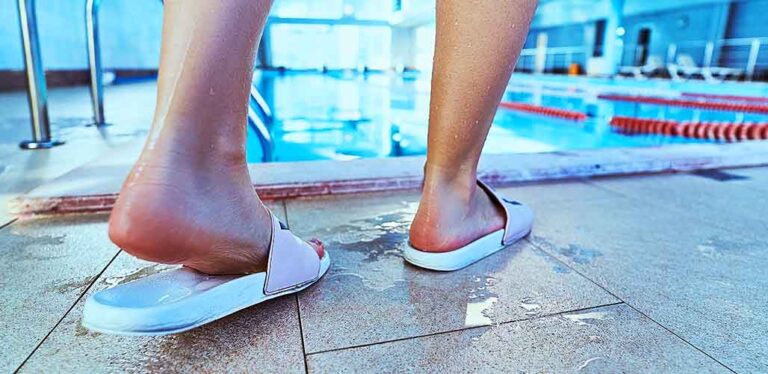What Do Swim Caps Do And Why Do They Break So Easily?
Do you ever have that frustrating experience of having a brand new swim cap, using it once or twice, and then finding it inexplicably broken? If so, you’re not alone! Swim caps break because they have elastic properties that don’t last forever, but they sometimes snap sooner than expected due to improper use too. Today I’ll look at what swim caps do, and share some of the reasons why they break. I’ll also give some tips to make them last longer.
Contents
- Why do swim caps break?
- Do latex swim caps break easily?
- How do you wear your swim cap?
- Old swim caps break more often
- Does long hair bust swim caps?
What Do Swim Caps Do?
So what exactly do swim caps do? And is it worth the trouble of learning how to prevent them from breaking?
There are several benefits to wearing a swim cap. If you are swimming in chlorinated pools, they give your hair some protection from the chlorine. They also keep hair out of your face and away from your mouth so that it doesn’t impede your breathing. And help to reduce the amount of hair that gets into the pool. The person cleaning the filters will thank you!
There are other benefits too, in terms of safety and speed. In open water a swim cap makes you more visible and easier to spot. And in competitive swimming a cap reduces drag and can help you swim faster.
With so many clear benefits, many of us will choose to use a swim cap. But getting to grips with that thin stretchy material can be a challenge!
Why Do Swim Caps Break?
Have you ever had your swim cap tear on you while in the middle of a race or workout? It’s annoying and embarrassing, but it can also be dangerous if the torn cap interferes with your vision. So why do swim caps break in the first place? The simple answer is that they were not designed to withstand extreme tension.
When pulled tightly onto the head, the material can stretch beyond its limit and rip. The type of material can also play a role; latex caps often offer more flexibility and durability, while silicone caps may be more likely to break under pressure. Ultimately, it’s essential to ensure that your swim cap fits appropriately and is not stretched beyond its limits to avoid any tears and ensure a safe swimming experience.

Are Latex Swim Caps Easy To Break?
When it comes to swimming, the right gear is crucial for a successful experience. While goggles protect your eyes and swimsuits help reduce drag in the water, swim caps also serve an essential purpose. Not only do they keep hair out of your face while swimming, but they also keep it contained and prevent chlorine from damaging your locks. But what are swim caps made of? In most cases, the answer is latex.
This natural material offers both stretchability and durability, allowing for a comfortable fit without fear of it breaking mid-swim. However, latex isn’t the only option on the market – some swim caps are made of silicone or nylon. No matter what material you choose, take proper care of your cap to ensure it lasts for many laps.
Tight Swim Caps Break Faster
The tight fit of a swimming cap may provide extra security against it being pulled off in the water, but it can also lead to something even worse: breaking. As you move your head around during swimming, the tight fit strains the material and can cause it to snap. This not only ruins your swim cap, but it can also leave behind small pieces that might get accidentally ingested by other swimmers.
Prevention is critical in this scenario – opting for a slightly looser fitting cap or even one made from stretchy material can help avoid this issue altogether. When choosing a swim cap, be sure to test its fit first and err on the side of caution for a comfortable, secure fit rather than risking a breakage later on. Your safety should always come first in the water.
Are You Wearing Your Swim Cap Right?
Swimming caps may seem like a trivial accessory, but they serve an essential function in protecting both the swimmer and their equipment. When worn correctly, a swimming cap helps to reduce drag and keep hair out of the way while swimming. However, if the cap is not put on correctly, it can also tear or break under tension.
To avoid this issue, stretch the cap before putting it on, starting with the bottom edge and working your way up to the top. Pull at the sides to ensure it fits securely without too much tension. And remember, never attempt to pull a wet cap over the wet hair – instead, dry off and comb hair before putting on the cap for maximum hold and protection. By following these simple steps, swimmers can enjoy the benefits of wearing a swimming cap without damaging their equipment.
Old Swim Caps Break More Easily
The next time you reach for that old, worn-out swimming cap in the bottom of your swim bag, think twice. Not only can an ill-fitting, torn cap cause discomfort and give you added drag in the water, but it may also break more quickly than a newer one. While a bit of wear and tear is inevitable with any piece of swimming gear, a regularly replaced cap can help to ensure both comfort and safety.
In addition to protecting your hair from chlorine damage and keeping it out of your face while swimming, a durable swimming cap can also protect against cuts or scrapes if it happens to break during use. So save yourself some hassle – and maybe even a trip to the first aid kit – and swap out that old cap for a fresh one before your next swim.
Does Long Hair Break Swim Caps?
When it comes to swimming, a critical aspect of practice and competitive preparation is having the proper equipment. One pivotal piece for any swimmer with long hair is a good, reliable swim cap. This can help prevent hair from getting in the way and keep chlorinated water out of the hair. However, long hair can also create problems for swim caps. Hair that is not adequately secured or not distributed evenly inside the cap can lead to tearing and breakage.
In addition, longer hair puts extra strain on the overall fit and structure of the cap, increasing the likelihood of breaks or tears. To avoid these issues, swimmers with long hair may want to consider a more robust swim cap material or tying their hair up securely before putting on their cap. Taking these steps can help prevent unexpected breakdowns during practice or competition.
How To Make Your Swim Cap Last Longer
If you want your swimming cap to stand the test of time, it’s essential to care for it properly. After every use, wash your swimming cap with mild soap and water to remove any chlorine or sweat. Air dry instead of using a towel or hair dryer, which can cause unnecessary friction and potential damage.
When not in use, store your cap in a cool, dry place away from direct sunlight. And lastly, make sure not to stretch or pull harshly on the cap while putting it on or taking it off – this will prevent any tears or breaks. Following these simple tips, your swimming cap will stay in top shape for years.
Why Do Swim Caps Break?
Swim caps made of latex which can stretch and become brittle over time. This causes them to snap when they are pulled too tight or when they get wet. To prevent your swim cap from breaking, make sure that you buy the right size for your head and avoid stretching it too tight. You can also wet your hair before putting on the swim cap to help it stay in place. Lastly, store your swim cap in a cool, dry place when you’re not using it. So, remember these tips next time you go for a dip and your swim cap will last much longer.
More Swim Cap Tips and Tricks
- Are latex or silicone caps better?
- Can a bald man wear a swim cap?
- Stop your cap falling off
- Water proof swim caps
- Finding a cap that fits long, curly hair







